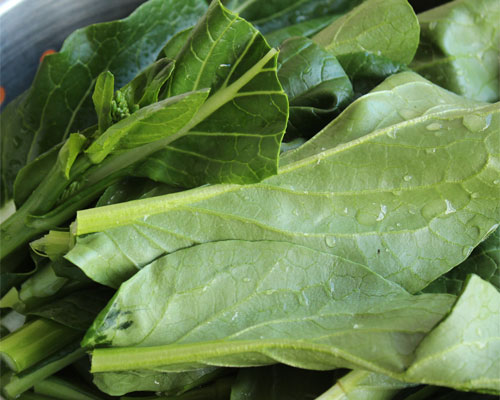Choi Sum (Brassica parachinensis) is a member of the Mustard family is also referred to as a flowering pak choy or choy sum. Its green leaves are juicy and tender. If allowed to mature and bolt, yellow flowers will shoot and the plant becomes sweeter and more succulent. The whole plant is edible.
Choi Sum is one of the most popular vegetables among the Chinese and is probably the most popular vegetable in Hong Kong. It is now also widely used in the western world.
The flowering shoots and younger leaves of Choi Sum are used in salads or stir-fried, lightly boiled or steamed and added to meat. Choi Sum is rich in carotene (pro-vitamin A), calcium and dietary fibre, it also provides potassium and folic acid.
The flavour itself can be described as midway between cabbage and spinach. Choi Sum tends to be blander and closer in taste to cabbage in younger leaves, and develops a little 'kick' in its older leaves. It is reputedly very nutritious, and in particular, is said to be rich in calcium.
Tsoi sum and cai xin (Chinese), cai ngot (Vietnamese), pakauyai or pakaukeo (Thai), saishin (Japanese), Chinese soup green, white flowering cabbage, mosk pak choy (English), Yau Choy, Yu Cai (Yeou Tsai), Chinese flowering cabbage oil greens, Yu Toy, and False Pak Choi.
Whole young leaves and stems, parts of larger leaves, and flowering shoots can be used in making salads. Choi Sum can be lightly boil, steam, stir-fry, combined with other greens and used in soups.
Cut off any woody portions of the stems and then slice the remaining stems and leaves into bite size pieces. Avoid steaming unless you prefer a very bitter taste. Lemon juice, garlic and red pepper flakes are great additions.
When storing Choi Sum cut off the thick stems below the twist tie. Then remove the twist tie from the stems to extend storage life. The tight ties can cause the stems to break down. Line a plastic bag with a paper towel to absorb excess moisture.
Although best eaten when fresh, Choi Sum can be stored in the refrigerator for 5-7 days.
Popular dishes: Chilli beef and Choi Sum, Sichuan beef with Choi Sum, Choi Sum and lamb with vegetable chunks, Hokkien noodles with fired tofu, choi sum and prawns and Stir-fried cauliflower, choi sum, and beans (pad pak ruam).
UK March-December | SPAIN December-March


